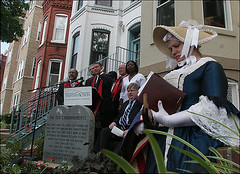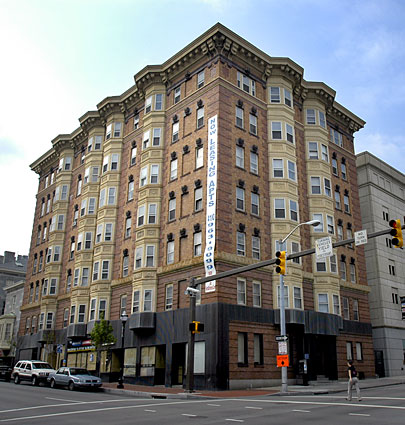Losing my religion (continued)
 Merrie Warren Turner, dressed as Betsy Ross, and other members of the evangelical Christian group Faith and Action unveiled a monument depicting the Ten Commandments in front of the group's offices in a Capitol Hill rowhouse this month. The property is across the street from the U.S. Supreme Court. (By Jahi Chikwendiu -- The Washington Post)
Merrie Warren Turner, dressed as Betsy Ross, and other members of the evangelical Christian group Faith and Action unveiled a monument depicting the Ten Commandments in front of the group's offices in a Capitol Hill rowhouse this month. The property is across the street from the U.S. Supreme Court. (By Jahi Chikwendiu -- The Washington Post)Officials in both DC and Baltimore have made bad decisions on planning and zoning regulations with regard to properties owned by religious organizations.
In Baltimore, Mayor O'Malley punted on letting the Archdiocese of Baltimore go forward with the demolition of an apartment building, according to a piece (part of a slew of letters to the editor) by Tyler Gearhart, director of Preservation Maryland:
Mayor Martin O'Malley recently approved a demolition permit for the historic Rochambeau apartment building located at Charles and Franklin streets downtown. Depending on your perspective, the mayor has either bowed to or hidden behind the archdiocese's threat to sue the city in the name of religious freedom if the permit was denied.
For the Baltimore Sun editorial on this issue, please click the link and here for the original article, "Rochambeau has to go, mayor says: Catholic Church wins fight to raze building."
Today's Post has a piece "City Drops Objections To Religious Sculpture" subtitled "Display Doesn't Need Permit, Agency Says," about the controversy on 2nd Street NE where an evangelical group installed a sculpture of the Ten Commandments in the front yard "to influence" Supreme Court Justices as they ride into work. Obviously, whizzing by in a car, you can't read squat on a tablet from 30 feet away, so this is merely grandstanding.
From the article:
More than three weeks after District officials warned an evangelical Christian group about displaying a sculpture of the Ten Commandments on property across the street from the U.S. Supreme Court, they said yesterday that the 850-pound granite monument doesn't need a permit after all. ...
Yesterday, Lars Etzkorn, associate director of the office of public space management administration at the Transportation Department, sent a letter to the group rescinding the earlier warning. The letter stated that, "In view of the First Amendment interests reflected in the installation of the Ten Commandments sculpture . . . and upon further consideration of applicable law," the city now believes that no permits are required.
The First Amendment forbids Congress to make any law prohibiting the free exercise of religion or abridging freedom of speech.
Both cases are a misuse of religious principles to planning and zoning decisions, not much different than "blue laws" (no longer extant in DC) that prohibit the sale of alcohol within a certain distance of a church.
Granted that I am not a lawyer, but the way I read the law is that local laws that somehow treat churches differently (and punitively in some way) and therefore impact the practice of religion, are what are covered.
Zoning and land use provisions that are the same for every property owner would not be included, although many many churches bring up this federal law in an attempt to get around zoning laws. Or financial hardship. A church in Virginia said they couldn't repair their steeple to historic preservation standards and that the federal law allowed them to vacate the preservation provisions. My sense is that again, hardship is not a defense when the laws treat every property owner equally.
However, there is a case in Georgia currently, where a municipality has a law that only allows churches to be located on sites where churches already existed (because of loss of properties from tax rolls), that is likely to be considered a clear violation of the act. (It's a pending case.) And in Montgomery County whether or not churches (megachurches) should be allowed to locate in the Montgomery County Agricultural Preserve is a contentious issue. (I say no. Pouring cars onto rural roads is not the intent of the law that created the Preserve to begin with.)
Another problem with this is the City's elected officials kow-towing to churches over the hardships that Sunday parking during services often causes area residents. I think that this use can be accommodated, but not if churches don't have to create and manage "transportation demand management" programs and not if they can avoid being brought to the table as a result of elected officials pandering.
 The Rochambeau, once a hotel and now a vacant apartment building, has stood for a century at Charles and Franklin streets. Preservationists argued for saving the Renaissance Revival building. (Sun photo by Chiaki Kawajiri). Sep 30, 2004. Recent studies find that the amount of housing stock deemed affordable in Baltimore and the Baltimore region is shrinking drastically.
The Rochambeau, once a hotel and now a vacant apartment building, has stood for a century at Charles and Franklin streets. Preservationists argued for saving the Renaissance Revival building. (Sun photo by Chiaki Kawajiri). Sep 30, 2004. Recent studies find that the amount of housing stock deemed affordable in Baltimore and the Baltimore region is shrinking drastically.Index Keywords: religion; zoning-regulations



0 Comments:
Post a Comment
<< Home